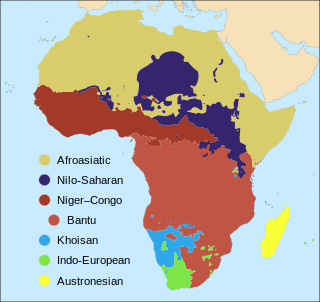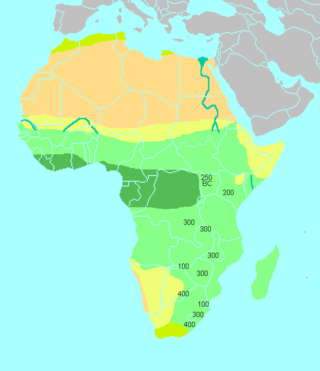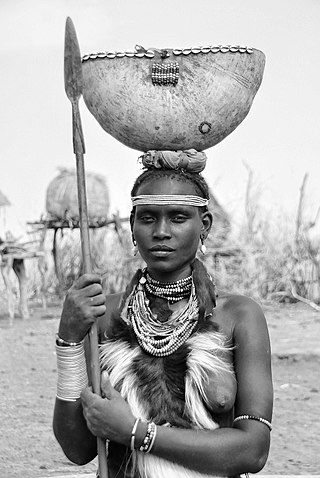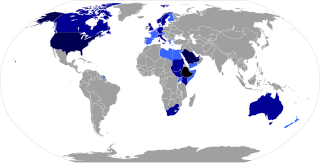
The Cushitic languages are a branch of the Afroasiatic language family. They are spoken primarily in the Horn of Africa, with minorities speaking Cushitic languages to the north in Egypt and Sudan, and to the south in Kenya and Tanzania. As of 2012, the Cushitic languages with over one million speakers were Oromo, Somali, Beja, Afar, Hadiyya, Kambaata, and Sidama.

The demography of Kenya is monitored by the Kenyan National Bureau of Statistics. Kenya is a multi-ethnic state in East Africa. Its total population was at 47,558,296 as of the 2019 census.

The number of languages natively spoken in Africa is variously estimated at between 1,250 and 2,100, and by some counts at over 3,000. Nigeria alone has over 500 languages, one of the greatest concentrations of linguistic diversity in the world. The languages of Africa belong to many distinct language families, among which the largest are:
The Nilotic peoples are people indigenous to the Nile Valley who speak Nilotic languages. They inhabit South Sudan, Sudan, Ethiopia, Uganda, Kenya, the eastern border area of Democratic Republic of the Congo, Rwanda, Burundi and Tanzania. Among these are the Burun-speaking peoples, Teso people also known as Iteso or people of Teso, Karo peoples, Luo peoples, Ateker peoples, Kalenjin peoples, Datooga, Dinka, Nuer, Atwot, Lotuko, and the Maa-speaking peoples.

The Bantu expansion is a hypothesis about the history of the major series of migrations of the original Proto-Bantu-speaking group, which spread from an original nucleus around West-Central Africa. In the process, the Proto-Bantu-speaking settlers displaced, eliminated or absorbed pre-existing hunter-gatherer and pastoralist groups that they encountered.
Lowland East Cushitic is a group of roughly two dozen diverse languages of the Cushitic branch of the Afro-Asiatic family. Its largest representatives are Oromo and Somali.
Waaq is the name for the sky God in several Cushitic languages, including the Oromo language and Somali language.

The Rendille are a Cushitic ethnic group inhabiting the Eastern Province of Kenya.
Kenya is a multilingual country.

The languages of Ethiopia include the official languages of Ethiopia, its national and regional languages, and a large number of minority languages, as well as foreign languages.

The Daasanach are an ethnic group inhabiting parts of Ethiopia, Kenya, and South Sudan. Their main homeland is in the Debub Omo Zone of the Southern Nations, Nationalities, and People's Region, adjacent to Lake Turkana. According to the 2007 national census, they number 48,067 people, of whom 1,481 are urban dwellers.
Barento is one of the two major subgroups of the Oromo people, a Cushitic ethnic group. They live in the West Hararghe Zone, East Hararghe Zone, Arsi zone, of the Oromia Region of Ethiopia while the other subgroup named Borana Oromo inhabiting Oromia Special Zone Surrounding Addis Ababa, West Shewa Zone, West Welega Zone and Borena Zone of the Oromia Region of Ethiopia.

The population of Africa has grown rapidly over the past century and consequently shows a large youth bulge, further reinforced by a low life expectancy of below 50 years in some African countries. Total population as of 2020 is estimated to be more than 1.3 billion, with a growth rate of more than 2.5% p.a. The total fertility rate for Africa is 4.7 as of 2018, the highest in the world according to the World Bank. The most populous African country is Nigeria with over 206 million inhabitants as of 2020 and a growth rate of 2.6% p.a.

Ethiopians are the native inhabitants of Ethiopia, as well as the global diaspora of Ethiopia. Ethiopians constitute several component ethnic groups, many of which are closely related to ethnic groups in neighboring Eritrea and other parts of the Horn of Africa.

The Iraqw People are a Cushitic ethnic group inhabiting the northern Tanzanian regions. They are believed to have originated from the southwestern Arusha and Manyara regions of Tanzania, near the Rift Valley. The Iraqw people then settled in the southeast of Ngorongoro Crater in northern Karatu District, Arusha Region, where the majority of them still reside. In the Manyara region, the Iraqw are a major ethnic group, specifically in Mbulu District, Babati District and Hanang District.

The Proto-Afroasiatic homeland is the hypothetical place where speakers of the Proto-Afroasiatic language lived in a single linguistic community, or complex of communities, before this original language dispersed geographically and divided into separate distinct languages. Afroasiatic languages are today mostly distributed in parts of Africa, and Western Asia.

The Gabra are a Cushitic ethnic group who mainly inhabit the Moyale and Marsabit regions of northern Kenya and the highlands of southern Ethiopia. They are closely related to the wider Oromo people and practice Islam as their religion.

The El Molo, also known as Elmolo, Dehes, Fura-Pawa and Ldes, are an ethnic group mainly inhabiting the northern Eastern Province of Kenya. They historically spoke the El Molo language as a mother tongue, an Afro-Asiatic language of the Cushitic branch, and now most El Molo speak Samburu.

Cushitic-speaking peoples are the ethnolinguistic groups who speak Cushitic languages natively. Today, Cushitic languages are spoken primarily in the Horn of Africa, with minorities speaking Cushitic languages to the north and south in Egypt, Sudan, Kenya, and Tanzania.

















